|
TRANSLATE THIS ARTICLE
Integral World: Exploring Theories of Everything
An independent forum for a critical discussion of the integral philosophy of Ken Wilber
 Keith McCaughin researched and developed new approaches to engineer enterprises by applying the emerging concepts of complex adaptive systems (CAS) to Enterprise Engineering. He has coauthored and published four papers that describe how people, processes, and technology contribute to Enterprise Engineering. Mr. McCaughin earned a Bachelor of Science in Information Systems from Columbia Union College, Takoma Park, Maryland and a Master of Science in Systems Engineering from Johns Hopkins University, Baltimore, Maryland. Keith McCaughin researched and developed new approaches to engineer enterprises by applying the emerging concepts of complex adaptive systems (CAS) to Enterprise Engineering. He has coauthored and published four papers that describe how people, processes, and technology contribute to Enterprise Engineering. Mr. McCaughin earned a Bachelor of Science in Information Systems from Columbia Union College, Takoma Park, Maryland and a Master of Science in Systems Engineering from Johns Hopkins University, Baltimore, Maryland.
Proposed Model to Aid Spiral Dynamics AnalysisKeith McCaughinContents
IntroductionThe Spiral Dynamics[1] model of human and social development can be included in a General Complex Adaptive Systems Model to help clarify ambiguities and further its utility in AQAL.[2] I have read essays that seem to ignore the spiral to consider stages as mutually exclusive, ignoring the transcend-and-include prior stages concept of AQAL, and other dynamic interplay within AQAL dimensions, especially lines of development. I propose this model to aid analysis using of Spiral Dynamics. “Social change is the result of an interacting network of various social tendencies, and relationships of many different kinds. There seems to be no single 'leading factor' which is always in the forefront and the relationship cannot always be reduced to a simple dichotomy - of either conflict or cooperation. In a given system, interactions between opposing tendencies can take many forms including: conflict, competition, cooperation and collaboration, which may coexist simultaneously. Actors in a social system may cooperate with regard to one pair of tendencies, compete over others, and be in conflict with respect to different sets at the same time.”[3] Gharajedaghi contends that “the continued treatment of multidimensional realities as uni-dimensional concepts - simple dichotomies or continua - is not only at the core of the confusion and dilemmas, but also represents a fallacy into which many people of good will often fall. The point is that sets of opposing tendencies - assumed to be the prime producers of change - are, in fact, two sides of the same coin; they coexist and interact continuously.”[4] In viewing AND/OR relations in the context of social dynamics, we are concerned with processes, not states. We are dealing with opposing tendencies, not opposing states. Firstly, there is the conceptualization of conflicting tendencies as two mutually exclusive, discrete entities. Here conflicts are treated as dichotomies which are usually expressed as 'X' or 'NX'. This represents an 'OR' relationship (this is not an inclusive OR but an exclusive OR (XOR), and thus a win/lose struggle which calls for a solution of the conflict. The loser is usually declared wrong and eliminated.  Secondly, there are uni-dimensional conceptions of conflict situations. Here conflicting positions are formulated in such a way that they can be represented by a continuum. Here there seem to be many shades of gray between black and white. This calls for compromise or resolution of the conflict.  A compromise is therefore a mixture of ideas of both poles of tension. It might seem to be a kind of integration, but this is usually quite superficial. It usually contains elements of the two extremes but it does not provide a new framework that can encompass both poles. 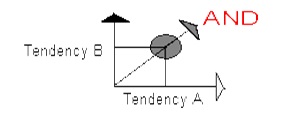 Thirdly there are multidimensional conceptions of conflict, in which interaction between opposing tendencies is characterized by an 'AND' relationship. In contrast to "OR', the 'AND' relationship recognizes the mutual interdependence of opposing tendencies. In this conception, the opposing tendencies not only coexist and interact, but also form a complementary relationship. A complement is that which fills out or completes a whole. 'Complementarity' is not a logical concept, nor is it the notion of the whole. The complementarities are not necessarily a pair. 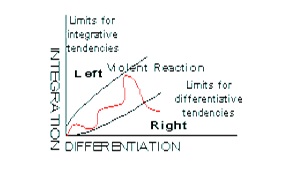 In a flexible social system, oscillations of lower amplitude occur without disruption within the critical cultural boundaries, as periodic shifts in governments, e.g. between Labour and Conservative parties in the UK, or Democrats and Republicans in the US, demonstrate. But in a polarized society, if a rigid orientation tries to cross the critical cultural line, a violent and destructive reaction will move it back to the other extreme, producing further frustration and greater oscillations, and, finally, cusping into a change of phase. Retrieval from such a situation is then extremely problematic, and the relationship between members is irreparably damaged as happens in societies which are thrown into a perpetual state of civil disorder as shown below. Therefore, corresponding to every level of differentiation, there exists a minimum required level of integration below which a system would disintegrate into chaos. Conversely, higher levels of integration require higher degrees of differentiation in order to avoid oppression. This leads to the conclusion that the periodic oscillations and disruptions witnessed in a social system are basically produced by dichotomous treatment of dialectical realities. Proposed ModeHere then is the proposed model with the Spiral Dynamics model embedded: 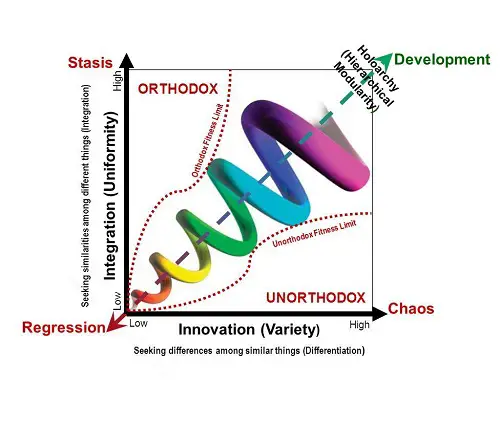 The diagram represents limits to and the direction of development of people and social systems of any kind. The following summary characteristics of the diagram are derived from the detail in the previous section or elaborated in the next section: Axles
Fitness and Fitness Limits
Spiral
Elaboration of the Main Diagram from Emerging TheoriesA set of interdependent variables forms a circular relationship. Each variable coproduces the others and, in turn, is coproduced by the others. Which one comes first is irrelevant because none can exist without the others. This phenomenon is found among any pair of interdependent variables such as integration and differentiation. Without an effective differentiation there can never be a meaningful integration.[5] 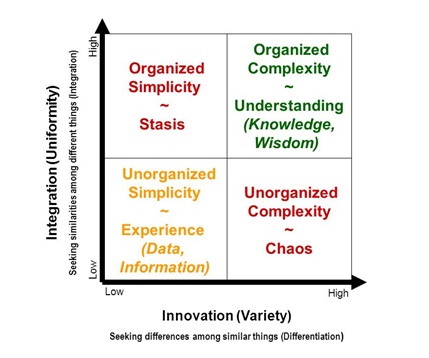 In its very basic form, we discover that organized simplicity (upper left quadrant) leads to stasis. What is the point and who cares? It's still just uninteresting noise. Unorganized complexity (lower right quadrant) is the reverse. It is too exciting and cannot be understood. It too is just noise. But unorganized simplicity (lower left quadrant) yields experiential data and information. According Russell Ackoff the elements of understanding are arranged in a hierarchy from data, perceived facts, to information, interpreted data, to knowledge, evaluated information, and wisdom, assimilated knowledge. Therefore, the experience of data and information supports the knowledge and wisdom of organized complexity, the result of development.[6][7] Power law of Extinction in Complex SystemsBiological evolution balances uniformity and variety in a process called recombination. Extinctions of species tend to follow a power law: a few large extinctions of extreme uniformity and many small extinctions of extreme variety. Stress levels on species go up as the balance between uniformity and variety is skewed in either direction, until eventually they exceed their tolerance level and become extinct. We call this a fitness limit.[8] Gharajedaghi[9] has observed this same phenomenon in organizations and governments. Complex system designs must be shaped by the management and engineering processes to avoid having so much variety, communion, that they become chaotic or having so much uniformity, agency, that they become static. We also know from Barabasi[10] et al that a few large extinctions occur at the extremes of the high/low integration axis and the low/high differentiation axis. The log of these extinctions produces a -1 curve or a straight line across the diagram bisecting the diagram from High to high. Fitness Limits of Complex SystemsOrmerod[11] describes fitness limits that run approximately parallel to the time line. Beyond these fitness limits, extinctions are highly likely. In terms of integral philosophy, anything beyond the fitness limits is pathologic. Steve McIntosh[12] says, “Goodness occupies the position of the synthesis (in thesis, antitheses, synthesis) in the way that it defines the useful limits of beauty and truth, in the way that it mediates between the maximum extension of inclusion and transcendence relative to each other. That is, as we've seen, evolution precedes through the interplay of opposing forces, and when either of these opposing forces is privileged or extended too far, the result is pathology. The avoidance of such pathology in any developmental situation is achieved by finding the dynamic equilibrium, the right relation, that brings these dialectical forces together in progressive, synthetic harmony. Goodness is thus revealed as it contrasts with the pathology it seeks to avoid.” 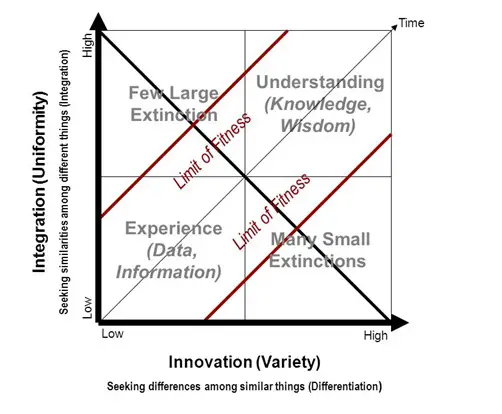 Effects of Youth and AgeStart Up"The probability of failure, or extinction, is known to be highest when the company is first formed. It then falls away rapidly. After a short time , just two or three years, the probability of failure in any period of time is then unrelated to the age of the firm."[13] Old Age"Soon, however, the value of more experience falls to zero. No matter how long the firm has survived, beyond the initial danger period the probability of failure in the immediate year ahead is virtually the same."[14] Normal development S-CurveThe S-shaped curve of development is consistent with this model. It does not take a great leap to see that the spiral of Spiral Dynamics is also consistent with this model. Impact of Strategy on Fitness"Once we allow the agents in the theoretical model to update their strategies with reasonable regularity, external shocks alone cannot generate the key features of firm extinctions which we observe. In particular, the relationship between the size and frequency of extinction events no longer emerges from the interplay between changes in the external stress levels and the stress tolerance levels of the individual agents."[15] “There are very considerable returns to acquiring knowledge, for even a small amount leads to a sharp increase in the average age of agents at extinction. Indeed we find that as both the amount of knowledge available to agents increases and as the number of agents capable of acquiring such knowledge rises, their life span begins to approach the limiting, full-information paradigm of conventional economic theory in which agents live forever. So if we can acquire knowledge about the impact of strategy, it is distinctly valuable."[16] In terms of integral philosophy, the higher the development the greater the scope of opposing tendencies that can be included, if balanced, and maintain health in the individual or group. Greater tolerance of more and opposing perspectives is evident in higher stages of development.  Here then is the full development of the basic diagram based on additional theories that leads back to the main diagram with AQAL Spiral Dynamics development stages embedded between the fitness limits of complex adaptive systems (repeated below): ConclusionI am aware that “Since all models are wrong the scientist cannot obtain a 'correct' one by excessive elaboration. On the contrary following William of Occam he should seek an economical description of natural phenomena. Just as the ability to devise simple but evocative models is the signature of the great scientist so overelaboration and overparameterization is often the mark of mediocrity.”[17] Even so, my model attempts to integrate the concepts of Spiral Dynamics and Complex Adaptive Systems to provide a more robust model. Surely it is wrong but it may be useful. Finally. with all this elaboration behind us, a much more simple approach would be to look at the Spiral Dynamics model from the bottom, looking up at it. We would see a dot growing in increasing circles to include everything within healthy development stages. End Notes
|